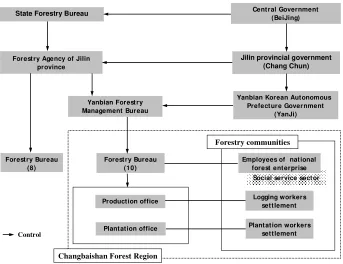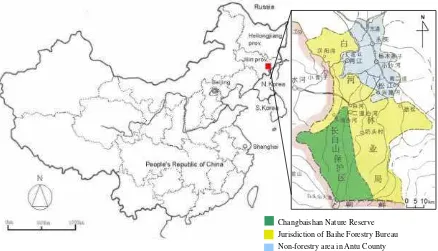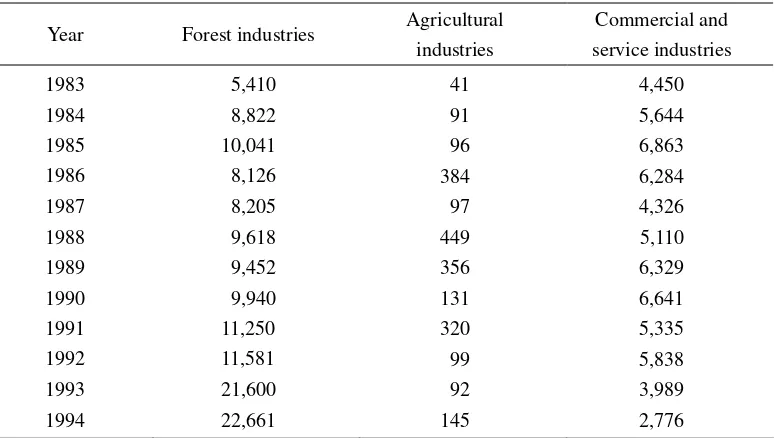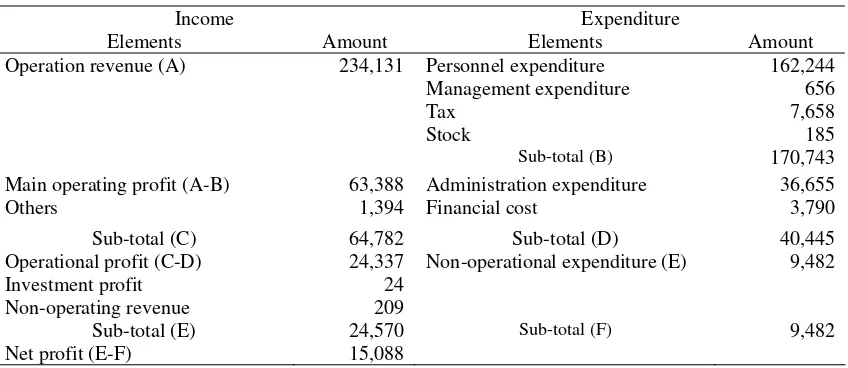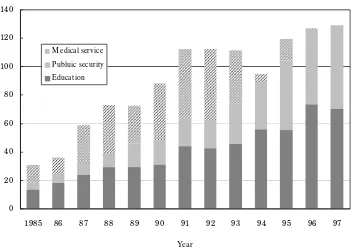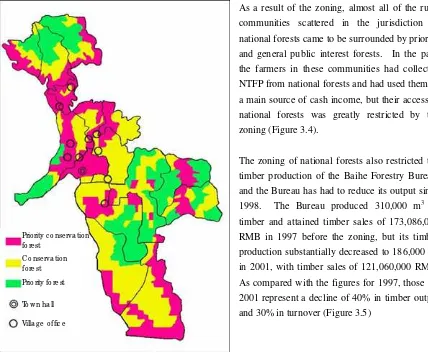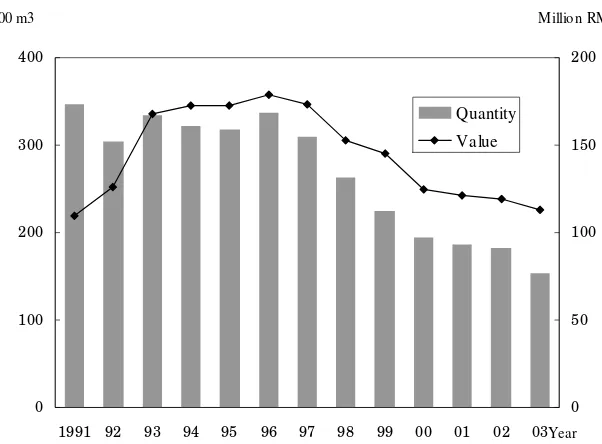CUI Tieyan, MOCHIDA Haruyukirest
Projects, and allocated almost three third of the total budget to these two projects in 2003. Unlike in F F CP, the budget for NF CP has been divided to various items of expenditure, from which we can find the peculiarity of natural forest management in China particularly in the three major natural forest distributions. This study aims to describe the characteristics of the management by national forest enterprises and impacts of NFSP on the management body as well as the local communities through a comparison of the situation before and after NFCP.
As already mentioned in Chapter 2, a national forest enterprise (quoyoulin qiye) generally consists of national enterprises (qianmin qiye) and group enterprises (jiti qiye). The former are directly operated by the state, and the employees are employed according to the government's labor force distribution plan and guaranteed lifetime employment in principle. To distinguish these employees of national enterprises from those of group enterprises, we call them "employees" here.
Group enterprises are the socialistic organizations where workers jointly own equipment and materials for production, work together, and share earnings among them according to their respective labor input. In the field, there two types ofgroup enterprises: those founded by the leadership of workers themselves, and those established by state enterprises or other business entities as the subcontracting organizations. The means of production of the latter type of group enterprises are owned by their parent enterprise or by a government agency. Group enterprises may enlarge their management scale at the request of their parent enterprise, while they may go bankrupt due to poor business results. The position of workers at group enterprises is not lifetime employment and can be determined by the enterprise. To distinguish the employees of group enterprises from those of national enterprises, we call the former "workers" here.
Social service sector
State Forestry Bureau
Forestry Agency of Jilin province
Yanbian Forestry Management Bureau
Forestry Bureau (8)
Forest ry Bureau (10)
Product ion office
Plantation office
Cent ral Government (BeiJing)
Jilin provincial government (Chang Chun)
Yanbian Korean Autonomous Prefecture Government
(YanJi)
Changbaishan Forest Region
Forestry communities
Control
Employees of national forest enterprise
Logging workers settlement
Plantation workers settlement
Figure 3.1 Organization chart of forestry bureau and forestry community
2. Implementation of Natural Forest Conservation Policy
2.1. Zoning of forestland under NFCP
The process to execute NFCP starts from zoning. Before NFCP, logging activities could be carried out all over the natural forests except protected areas. The central government first imposed zoning system and forests were categorized to conservation forest (literally public interest forest) and production forest. Conservation forests are subdivided to priority conservation forests and ordinary conservation forests. The criteria of zoning are as follows:
Priority conservation forest:
Forests on the head of large rivers, catchments of class A tributaries, catchments of class B tributaries with fragile ecosystems, and steep slopes of high elevation, forests around large dams and lakes, and other forests which is considered would be easily destroyed and whose restoration is regarded as being difficult are categorized to priority conservation forest. In these forests, logging activities are totally banned.
Conservation forest:
In this category of forests, it is aimed to make conservation of the ecosystem and sustainable use of forest resources compatible. The growth of forest trees and increase in the forest stock are promoted through an appropriate implementation of selective cutting and tending of trees according to the state of resources.
Production forest:
categorized into production forests. In this category of forests, production activities can be continued, either by clear cutting or by selective cutting.
These strategies are expected to help restoration of deteriorated natural forests in China and to promote a transition in the forest operation base from natural resources to artificial forests.
2.2. Financial support by the Central Government associated with NFCP
To attain the aim of natural forest conservation, the Central Government of China prepared a budget of 4.44 billion RenMinBi (RMB) in 1998 and 7.04 billion RMB in 1999. For the period from 2000 to 2010, a subsidy plan totaling to 96.20 billion RMB has been drafted, 80% to be borne by the Central Government and 20% by local governments. According to this plan, 10.01 billion RMB was inputted in 2000, and 9.60 billion RMB in 2001 (Zhao, 2001). These subsidies can be mainly divided into the following items of expenditure:
Forest management:
Forest management expenditure is to make up for the costs needed for forest management and protection to the forest management body that has natural forests in the jurisdiction. It includes plantation costs, labor costs and costs of equipment purchase and repair.
Compensation for the public service (literally policy and social outlay):
This is a subsidy for costs required for the maintenance of communities that consist of the people involved in national forest management. In the past, the costs of public services such as primary and secondary education, health and medicine, and security maintenance were disbursed from the budget of the national forest enterprise and were treated as non-operating expenses in the accounting of business income. But it gradually became difficult for enterprises to bear all of the costs. As a result, it was decided that the Central Government would provide subsidies for part of public services.
Compensation for employee's retirement pension insurance:
Employee's retirement pension insurance is the lifetime pension insurance plan managed by the government, which is operated under the fund composed of the premiums that both enterprises and employees are obliged to pay. Formerly enterprises contributed 20% of the total payment of wages, and persons insured paid 8% of the wages. After the implementation of NFCP, however, laid-off employees and workers drastically increased. As a result, the payment of these premiums became a burden both to the enterprises suffering a fall in income and to these laid-off employees and workers. Compensation for employee's retirement pension insurance is a government financial assistance to these premium payers.
Basic income guarantee:
Retirement lump sum (literally comprehensive proper measure):
This is to make up for the retirement allowance provided to the employees who have voluntarily retired. The amount differs from enterprise to enterprise and according to the length of service, and the payment of the retirement allowance terminates the employee's contract with the enterprise.
3. General settings of Changbaishan forest region
3.1. Natural conditions of Changbaishan forest region
Changbaishan (Mt. Changbai) is situated on the border between Yanbian Korean Autonomous Prefecture, Jilin Province, China, and the Democratic People's Republic of Korea (Figure 3.2). The Changbaishan forest region contains all of the prefecture's forests within its jurisdiction, and the Yanbian Forestry Management Bureau controls the resources. Forestry management bureaus were established for the purpose of operating and managing forests in the specific areas very important to forestry in China, which are generally subdivided to several forestry bureaus. Yanbian Forestry Management Bureau is under the control of the Jilin Provincial Forestry Agency and divided to ten forestry bureaus. The natural forests at the foot of Mt. Changbai are included in the jurisdiction of the Baihe Forestry Bureau and administratively located in the Town of Erdaobaihe, Antu County.
Changbaishan Nature Reserve Jurisdiction of Baihe Forestry Bureau Non-forestry area in Antu County
F igure 3.2. Jurisdiction of Baihe Forestry Bureau (Yanbian Forestry Management Bureau, 1997)
communities were borne by the national forest enterprise, and the entire community was operated by the felling of forest trees. As of 1995, the employees at the national forest enterprises under the control of the Baihe Forestry Bureau totaled to 9,115, of whom 6,840 were those involved in production activities and 2,275 were responsible for the management of the community.
With the liberalization of economic activities and the tourist development of Mt. Changbai, people other than those involved in the national forests began to flow into the central area, too, and began to run stores, restaurants, taxi business and other commercial activities. The families of employees and workers are engaged in these side jobs and also collect non-timber forest products like farmers to help out with the family budget. As one of the major producing areas of edible wild plants in China, the Changbaishan forest region exports these plants, too.
3.3. Development of the group enterprises under the Baihe Forestry Bureau
The workers at the group enterprises totaled to 5,616. Of those 2,554 were the workers at the manufacturing enterprises, and 3,062 at service enterprises, the latter more than the former. Owing to the introduction of the reforms and open-door policies in the 1980s and after, group enterprises attained a great development and have an important position in the management of national forest enterprises. But as discussed later, with declining timber production, the life of workers at group enterprises after retirement has posed a serious problem, and these enterprises are also faced with the need for drastic reforms.
Table 3.1. Income of group enterprises in the Baihe Forestry Bureau
Unit: 000 RMB
Year Forest industries Agricultural industries Commercial and service industries 1983 1984 1985 1986 1987 1988 1989 1990 1991 1992 1993 1994 5,410 8,822 10,041 8,126 8,205 9,618 9,452 9,940 11,250 11,581 21,600 22,661 41 91 96 384 97 449 356 131 320 99 92 145 4,450 5,644 6,863 6,284 4,326 5,110 6,329 6,641 5,335 5,838 3,989 2,776
Source: Editing Committee of the Baihe Forestry Bureau, 1992, 1994, 1996.
this is that in 1992 when China switched to a market economy system and after, privately-run businesses rapidly increased in the service industry, which fact had direct impact on group enterprises. On the other hand, forest product processing industries, which used windfalls and felling remnants as materials, made a great development (Table 3.1). But needless to say, the timber processing sector, whether national forest enterprises or group enterprises, was later affected by NFCP because they had achieved growth by the use of timber as materials.
3.4. E xpansion in timber production
In 1971 when the Baihe Forestry Bureau was established, national forest enterprises began timber production according to the state production quota under the planned economy regime. In the three-year construction period from 1971 to 1973, 122,000 m3 of timber was produced to meet the construction demand of national forest enterprises and communities. Timber output increased year by year after that and reached 189,000 m3 in 1977 (Editing Committee of the Forestry Bureau Bulletin 1989).
In March 1981, the Central Committee of the Chinese Communist Party and the State Council promulgated the "Decision on Some Problems of Forest Conservation and Forestry Development," and urged group-owned forest offices and national forest enterprises to reinforce the management of logging sites and to control timber production. In September of the same year, the Ministry of Forestry in China enacted the "Regulations on Reinforcement of Forest Management of National Forest enterprises in National Forest Areas in the Northeast and Inner Mongolia," and requested prompt steps to prevent the amount of trees felled from exceeding tree growth.
However, it was difficult for national forest enterprises to discontinue the practice of overcutting unless the problems brought over from the past, such as the too high target of the timber production plan, allotted payments of profits to the government, the obligation to maintain and develop the community and the need to guarantee the living standard of workers, were solved. Thus, these government policies were still unable to check decrease in forest resources. Moreover, the profit retaining system was introduced in 1979 and national forest enterprises were now able to reserve 5% of their profit. This system drove these enterprises to overcut forests further in an attempt to increase the portion of their reserves.
Against the background as stated above, the timber production of the Baihe Forestry Bureau showed further increases, and the yearly average output in 1986 and after was over 300,000 m3 (Editing Committee of the Forestry Bureau Bulletin 1992, 1994, 1996). This resulted in additional great declines in the stock of matured and over-matured forests under the Bureau's control.
In 1993 and after, the state control over timber distribution and prices was almost all removed, and the pricing of forest products was left to enterprises. But as the resources for felling were virtually exhausted themselves, most national forest enterprises were faced with the so-called "double blow" of management, i.e., the risk of forest resources and the risk of management, and their operation turned into a deficit one.
noteworthy fact is that the forest stock in this Bureau's jurisdiction was comparatively ample. Thus the Bureau's timber production did not decrease even in the 1990s, recording a yearly average of 300,000 to 350,000 m3 until 1997. In addition, unlike most other forestry bureaus, this Bureau was able to continue profitable operation in the 1990s, too. But overcutting was behind this just as in other regions, and the Bureau's stock of Korean while pine and other valuable tree species especially suffered a marked decline.
According to the forest resource study by the Forestry Research and Planning Council of Jilin Province (2000)in 2000, the matured and over-matured forests under the Bureau's jurisdiction had a total area of 55,523ha and a stock of 12,296,007m3. These are a decrease of 31.3% in area and 37.6% in stock from the figures of the previous study in 1993.
3.5. Increase in the non-operating expenditure of the Baihe Forestry Bureau
Until the Baihe Forestry Bureau began logging activities in earnest, the area below Mt. Changbai had been sparsely populated and had had no established local administration system. The industries that grew in the area with the development of national forest management were only those related to national forests, and no other industries were able to go into this area. Because of this, initial projects, including infrastructure development, had to be carried out by national forest enterprises themselves. Thus, these enterprises started activities for building the community in this region by supporting all aspects of the life of workers and their families, while securing labor for forest development. The community was actually composed of employees and their families, and its administrative service section was incorporated into the management function of national forests, together with the organization and workers, as part of the Bureau.
Table 3.2. Income account of the Baihe Forestry Bureau (1994)
Unit: 000 RMB
Income Expenditure Elements Amount Elements Amount
Operation revenue (A) 234,131 Personnel expenditure Management expenditure Tax
Stock
162,244 656 7,658 185
Sub-total (B) 170,743
Main operating profit (A-B) Others
63,388 1,394
Administration expenditure Financial cost
36,655 3,790
Sub-total (C) 64,782 Sub-total (D) 40,445
Operational profit (C-D) Investment profit Non-operating revenue
24,337 24 209
Non-operational expenditure (E) 9,482
Sub-total (E) 24,570 Sub-total (F) 9,482
Net profit (E-F) 15,088
Source: Statistical data from the accounting section of Baihe Forestry Bureau
This non-operating expenditure was actually the funds needed for the management of the community. After deducting non-operating expenditure from the operating income, the national forest enterprise paid the remaining part of the profit to the government. This was the mechanism of profit distribution by the national forest enterprise, in which the expenses needed for the community's management were given priority over profit payment to the government. If the non-operating expenditure of the national forest enterprise became greater than its operating income and thus the enterprise went into the red, either the enterprise was exempt from profit payment or the state finances made up the deficit as far as the red figures arose due to a reasonable cause. Thus it can be said that the expenses necessary for the community's maintenance and development were guaranteed institutionally.
The non-operating expenditure of the Baihe Forestry Bureau increased every year, casting an ever-growing burden on the Bureau's operation. During the decade from 1985 to 1994, these expenses rose by about three times (Figure 3.3). The expenses included those for education (primary and secondary schools), public security (police, prosecution, and court trials), and medical services (medicine, public health and hygiene) and others. As a result of expanding communities and growing population, these expenses had higher ratios and showed remarkable increases.
Since 1994, as its management situation has worsened, the Bureau's hospital section has been separated as an independent one under a self-supporting accounting system. After the year, the Bureau's non-operating expenses have been roughly 10 million RMB a year.
0 20 40 60 80 100 120 140
1985 86 87 88 89 90 91 92 93 94 95 96 97
Year Million RMB
M edical service
Publuic security
Education
Source: Editing Committee of the Baihe Forestry Bureau, 1992. 1996, 1998, 2003.
4. Impact of NFCP on national forest enterprises
4.1. Zoning of national forests and decreasing timber production
The Baihe Forestry Bureau decided to start the natural forest conservation plan as early as in the second half of 1998, and the national forests under its control were immediately subjected to zoning. The area of the priority public interest forests for which the measure of "forest development by prohibition of felling" would be taken was 46,264ha or 25.2% of the forests owned by the Bureau. The area of general public interest forests, where selective felling and afforestation activities were permitted, was 73,000ha (39.3%), while that of production forests, where ordinary forestry activities could be carried out, was 64,000ha (35.0%).
As a result of the zoning, almost all of the rural communities scattered in the jurisdiction of national forests came to be surrounded by priority and general public interest forests. In the past, the farmers in these communities had collected NTFP from national forests and had used them as a main source of cash income, but their access to national forests was greatly restricted by the zoning (Figure 3.4).
Villa g e o ffic e To wn ha ll Prio rity fo re st Co nse rva tio n fo re st
Prio rity c o nse rva tio n fo re st
The zoning of national forests also restricted the timber production of the Baihe Forestry Bureau, and the Bureau has had to reduce its output since 1998. The Bureau produced 310,000 m3 of timber and attained timber sales of 173,086,000 RMB in 1997 before the zoning, but its timber production substantially decreased to 186,000 m3 in 2001, with timber sales of 121,060,000 RMB. As compared with the figures for 1997, those for 2001 represent a decline of 40% in timber output and 30% in turnover (Figure 3.5)
0 100 200 300 400
1991 92 93 94 95 96 97 98 99 00 01 02 03Year 000 m3
0 50 100 150 200
Million RMB
Quantity Value
Source: Unpublished statistics provided by the accounting and planning section of the Baihe Forestry Bureau.
F igure. 3.5. Changes in the timber sales and income of the Baihe Forestry Bureau
4.2. E ffects of zoning on national forest enterprises
(1) Grants from the Central Government
[image:11.595.100.401.107.329.2]The Central Government drafted a grant program to help make up for the Bureau's decrease in income (Table 3.4). But the amount of the grant paid to the Bureau between 1998 (when the provision of the grant was started) and 2001 totaled only to 86.12 million RMB, which is about 60% of the drop in the revenues from timber sales in these years, which amounted to 148.47 million RMB. The Bureau spent 15.1% of the grant to supplement the costs of retirement allowances for the laid off workers and voluntarily retired people resulting from the reduction program in workforce aiming at the rationalization of management, which does not mean that the provision of the grant did not guarantee the Bureau the continuance of its traditional management system.
Table 3.4. Central Government’s grants associated with NFCP
Unit: 000 RMB
Year Forest
management Compensation
Retirement pension insurance
basic income guarantee, retirement lump sum
Total
1998 680 1,260 1,280 0 3,220
1999 3,380 6,960 6,520 0 16,860
2000 4,250 11,660 9,600 2,170 27,680
2001 4,250 13,660 9,600 10,850 38,360
[image:11.595.80.525.629.744.2]In 1998, using part of the government grant allocated to forest management, the Baihe Forestry Bureau began to expand its divisions for standing timber improvement and for afforestation, and assigned some employees and workers to these divisions. But the workload of these divisions was not large enough to absorb all of the surplus labor generated from reduction in production.
The amount of "compensations", which are used for the maintenance and management of communities in the region of national forests, i.e. for filling a shortage of nonoperating expenses, is about the amount borne by national forest enterprises in the past, which is 10 million RMB a year. This means that thus far, these outlays have not been affected by the rationalization and that the Central Government assumes the payment of most part of these expenditures.
(2) Rationalization of management systems and national forest enterprises
The traditional complex management system of national forest enterprises was an obstacle to a quick decision on management policies and their prompt implementation. Thus in the second half of the 1990s, especially after the natural forest conservation plan was started, these enterprises made reforms in their management system aiming at "personnel cut and higher efficiency" and reduced high-ranking employees. Further in June 2002, the Baihe Forestry Bureau established and enforced the "Plan to Reform the Management System of the Baihe Forestry Bureau."
As a result, the Bureau's sections were reduced from 41 in 1995 to 21, and 442 of its 752 leading employees were discharged, cutting these employees to 310. At the same time, the Bureau has worked to clarify the relations in business between different sections and to unify its supervision system for all of the national forest enterprises under its control. The chief of the Bureau now has the power to appoint the managers of each division, and the managers are authorized to nominate the employees under them.
The Bureau encourages surplus employees to move to other enterprises or divisions according to their ability and adopts the system of voluntary retirement and the internal retirement system as well. Under this system, employees before the retirement age are discharged but are paid wages until the retirement age. Other excess employees are laid off and receive reemployment education at the Bureau's Reemployment Training Center.
(3) Livelihood security for the workers of group enterprises
In conformity with the "Opinions on Standardized Provision of Security Measures to Workers of Group enterprises" of the Labor Security Agency of Jilin Province, the Baihe Forestry Bureau introduced the
zhuanzhi (job change) system for Workers of Group enterprises under the Jurisdiction of the Baihe Forestry Bureau" in May 2002. Under this system, the workers of group enterprises can become the employees of national forest enterprises if they so wish. The Chinese term zhuanzhi is used hereinafter to refer to this job change system.
with most of them treated as laid-off employees. However, if the worker becomes an employee of a national forest enterprise by zhuanzhi, he or she can switch to a provincial retirement insurance plan, which is supported by the state budget and is thus safer, from a county-level retirement insurance plan, which is run by the local-government budget and is more risky. The worker-turned-employee bears the cost of this switchover, 2,100 RMB. The funds for reserves for retirement insurance after zhuanzhi are contributed both by the national forest enterprise and the employee in accordance with the contract between them.
The workers at the group enterprises whose management conditions are relatively good generally choose to retain their present position as such workers. But the management situation in group enterprises is worsening on the whole, and the workers at these enterprises are not guaranteed a stable employment in the future.
In addition, there is a group of workers who switched to private management in the late 1980s and after and virtually left group enterprises. Group enterprises reserve the status of these workers as "unpaid retained workers." It is supposed that most of these people are now working in the service industry, etc., and have achieved relative success. If these workers, who choose neither zhuanzhi nor continued employment at the group enterprise, do not express any particular intention within the predetermined period, their employment relation with the group enterprise is terminated.
As group enterprises, which had temporarily expanded as the subcontractors of national forest enterprises, were downsized and wound up in more and more cases, the problem of security for workers' life was solved by the zhuanzhi to some extent. Also, the reinforcement of the "unpaid retained workers" system made it possible to check those people who retained their position at their original group enterprises but even whose whereabouts were unable to confirm.
(4) Diversification of the operation of national forest enterprises
Since 2000, the Baihe Forestry Bureau has attempted to convert its forest management strategy into "forest management by classification" with a view to realizing a more diverse use of resources in its jurisdiction of national forests, breaking out of the traditional heavy dependence on timber production. Then in March 2002, the Bureau established and enforced the "Development and Management Method of Resources of the Baihe Forestry Bureau (hereinafter the "Development and Management Method)."
The Bureau is now aiming at switching to "planting business (planting of crops under trees)," fish-farming, NTFP collecting business, forest products processing, mining, natural water development and travel agent business. The enterprises under the Bureau's control draw up a resources development plan and report the plan to the Bureau's section in charge, and the plan is carried out after it has been deliberated and approved by the section. The Bureau can decide the implementation of a forest development project amounting up to 50,000 - 200,000 RMB, but the deliberation by the Yanbian Forestry Management Bureau, its superior organization, is required for the projects of over 200,000 RMB.
according to the provisions of the contract. In the case of investment by the enterprise, the profit of the development project entirely becomes the enterprise's income.
4.3. Reshuffles and layoffs of employees and workers
In 1998, the Baihe Forestry Bureau coped with the surplus labor generated as a result of reduction in production activities by shuffling it to the reforestation (literally forest management) and conservation sections. Starting 1999, however, a layoff system was introduced to deal with rapidly increasing excess employees and workers (Table 3.5). About 30% of the Central Government grant to the Bureau in 2001 was allotted to security for livelihood of these people and to allowances for voluntarily retired people. The Bureau's laid-off employees and workers reached 3,739 in 2001, and were expected to increase further in 2002. The assistance allowance, which is supplemented by the government grant, is 150 RMB across the board, but this amount is only one-fifth the average wage in 1997 before the introduction of the layoff system (the interview at the Bureau's Reemployment Training Center in July 2001). Naturally, layoff is a great blow to the livelihood of employees and workers and their families.
Since 2001, the Baihe Forestry Bureau has applied a voluntary retirement plan to its employees. The amount of allowances for voluntarily retired people is 1,220 RMB per one year of service, and if the years of service exceed 25, the allowances are computed as if the years had been 25 years. But because the budget for retirement allowances has an upper limit, the Bureau could not apply the plan to all of the employees who wish to voluntarily retire. In 2001, there were 6,979 employees who applied for voluntary retirement, but the plan was fulfilled only for 447 of these employees (the internal documents of the Planning Department.). The portion of the Central Government grant for security for life is used as the fund for the implementation of the plan.
Table 3.5. Personnel reshuffles associated with the assistance allowance project
Unit: person
Reshuffles Year
Reforestation Conservation Nursery Total Layoff
Voluntary retirement
1998 886 769 0 1,655 0 0
1999 605 1,065 0 1,670 1,534 0
2000 539 228 11 778 2,768 0
2001 573 243 70 886 3,739 447
Source: Internal documents of the planning section, Baihe Forestry Bureau.
4.4. Implementation of the forest leasing policy
which habitat is mountain streams and the fat is extracted and sold for medicinal purposes, the contract period is 5 - 8 years and the lease area is 80 - 200 ha. For other types of resources development activities, such as planting of crops under trees, the period is 3 - 5 years and the leased area is 10 - 200 ha.
Article 23 of the Method provides that employees and workers shall perform resources development activities in accordance with a contract with the Baihe Forestry Bureau, shall not carry out any subversive activities, and shall pay the development expenses in an amount fixed for each type of activities to the Bureau (Table 3.6). If the contractor fails to pay the development expenses, the Bureau may cancel the contract with the contractor or may impose a fine on the contractor.
hand, faced with the policy's natural outcome, i.e., reduced production and income, the Bureau had to scale down and rationalize its organization, which had been in a state of all words and no action in the past.
The livelihood of retired and laid-off employees and workers is secured to some extent by grants from the Central Government, and the funds for non-operating expenses needed for the management of the community are totally furnished. Since only the minimum security for the life of retired or laid-off employees is provided by the government, workers has urged them to be independent by, for example, doing business on their own account. As a means to accept these independent employees and workers, the Bureau adopted the forest leasing policy and established the right to NWFP in its national forests exclusive to these people, thus encouraging them to manage the entire forestland.
On the other hand, the introduction of the forest leasehold policy posed a new problem: the farmers in and around national forests had been allowed to enter the forests and had earned cash income by selling the NWFP they collected, but the policy resulted in driving out these farmers from national forests, which may have made it difficult for them to earn a livelihood. Moreover, has the development of the Changbaishan Forest Region as a tourist resort by the road construction project carried out in the same period as the Bureau's rationalization plan been able to accept retired and laid-off employees and workers? If not, what will be able to support the life of these people? These problems are among the subjects that remain to be studied in the future.
References
Asahi Shimbun, July, 9 2002. Tokyo, Japan.
Dai Y. and Akaha T., 2000. Chugoku no kokuyurinkeiei to chiikishakai: Heilongjiang kokuyurin no tenkaikatei (Japanese). Nihon Ringyo Chosakai, Tokyo, Japan.
Editing Committee of the Baihe Forestry Bureau, 1992. Year book of Baihe Forestry Bureau: 1986-1990 (in Chinese). Baihe Forestry Bureau, Chifeng, China.
Editing Committee of the Baihe Forestry Bureau, 1994. Year book of Baihe Forestry Bureau: 1991-1992 (in Chinese). Baihe Forestry Bureau, Chifeng, China.
Editing Committee of the Baihe Forestry Bureau, 1996. Year book of Baihe Forestry Bureau: 1993-1994 (in Chinese). Baihe Forestry Bureau, Chifeng, China.
Editing Committee of the Baihe Forestry Bureau, 2003. Year book of Baihe Forestry Bureau: 1995-2000 (in Chinese). Baihe Forestry Bureau, Chifeng, China.
Editing Committee of the Forestry Bureau Bulletin, 1989. History of forestry in Baihe Forestry Bureau (in Chinese). Baihe Forestry Bureau, Yanji, China.
Forestry Research and Planning Council of Jilin Province, 2000. Report of forest resources research in the Baihe Forestry Bureau (in Chinese). Forestry Research and Planning Council of Jilin Province, Changchun, China.
Yanbian Forestry Management Bureau, 1997. Yanbian forest resources statistics: outline of forest offices. Yanji, China. Zhao M., 2001. Sustainable implementation of the Natural Forest Conservation Policy: analysis from financial aspects
